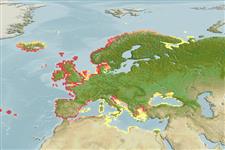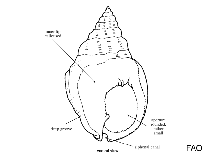Nassarius incrassatus (Stroem, 1768)
Thick lipped dog whelk| Native range | All suitable habitat | Point map | Year 2050 |

|
| This map was computer-generated and has not yet been reviewed. |
| Nassarius incrassatus AquaMaps Data sources: GBIF OBIS |
Google image | No image available for this species;
drawing shows typical species in Nassariidae.
Classification / Names Common names | Synonyms | CoL | ITIS | WoRMS
Gastropoda | Neogastropoda | Nassariidae
Environment: milieu / climate zone / depth range / distribution range Ecology
Demersal; depth range 3 - 30 m (Ref. 96485). Subtropical
Distribution Countries | FAO areas | Ecosystems | Occurrences | Introductions
Northeast Atlantic, Arctic and the Mediterranean. Subtropical to polar.
Length at first maturity / Size / Weight / Age
Maturity: Lm ? range ? - ? cm
Life cycle and mating behavior Maturity | Reproduction | Spawning | Eggs | Fecundity | Larvae
Main reference
References | Coordinator | Collaborators
Gusso, C.C., M.F. Gravina and F.R. Maggiore 2001 Temporal variations in soft bottom benthic communities in central Tyrrhenian Sea (Italy). Archo Oceanogr. Limnol. 22:175-182. (Ref. 2780)
IUCN Red List Status
(Ref. 130435: Version 2025-1)
CITES status (Ref. 108899)
CMS (Ref. 116361)
Threat to humans
Human uses
| FishSource |
Tools
More information
Max. ages / sizes
Length-weight rel.
Length-length rel.
Length-frequencies
Mass conversion
Abundance
Internet sources
BHL | BOLD Systems | CISTI | DiscoverLife | FAO(Publication : search) | Fishipedia | GenBank (genome, nucleotide) | GloBI | Gomexsi | Google Books | Google Scholar | Google | PubMed | Tree of Life | Wikipedia (Go, Search) | Zoological Record



